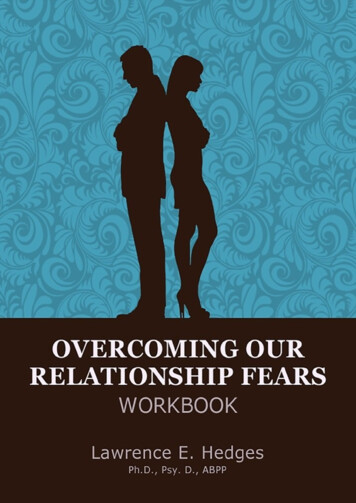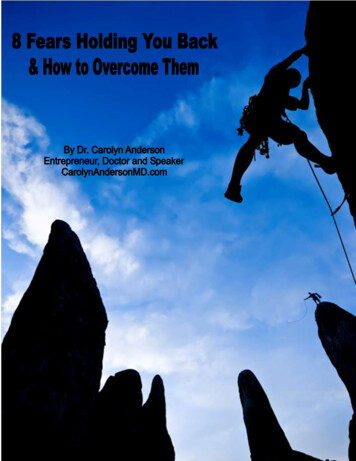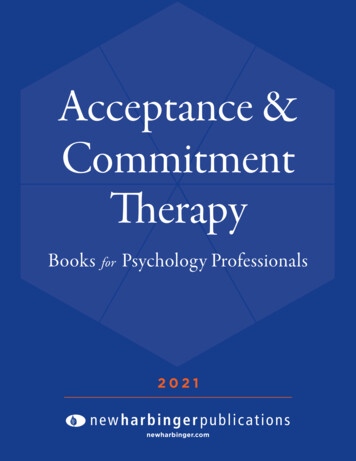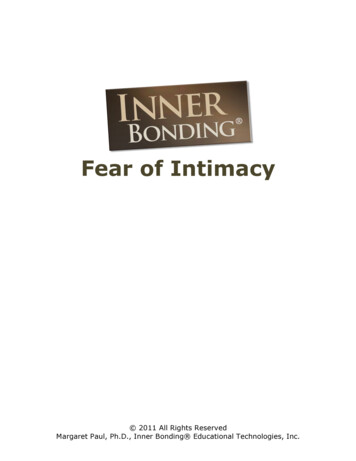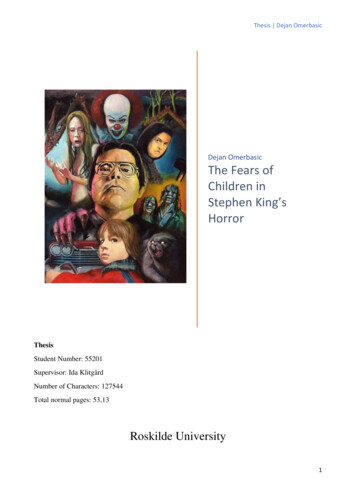
Transcription
Thesis Dejan OmerbasicDejan OmerbasicThe Fears ofChildren inStephen King’sHorrorThesisStudent Number: 55201Supervisor: Ida KlitgårdNumber of Characters: 127544Total normal pages: 53,13Roskilde University1
Thesis Dejan OmerbasicAbstractThis aim of this thesis is to explore which fears are being depicted through the child protagonists inStephen King’s Carrie (1974) and The Shining (1977). The thesis seeks to observe how these fearsoppose the common understanding of the time period in which these novels were published. Througha literary analysis of both novels, it can be concluded that both novels feature the theme of childabuse. The fears of the child protagonists are caused by the verbal and physical abuse of their parents,namely Margaret White and Jack Torrance. By examining the past of these abusive parents, it isrevealed that both parents suffered their own forms of abuse. This suggests that child abuse isintergenerational within families. This finding opposes the established belief in the 1970s, that childabuse could mostly be attributed to poor socio-economic status. Using the theory of the uncanny, itcan be argued that King induces the feeling of uncanny by blending the familiar with the unfamiliar.King establishes the familiar with his writing style, characters and settings, before unleashed thehorror in the form of physical and verbal abuse. King echoes the emerging research of the period,showcasing that child abuse can be found in any home in the country, regardless of social or economicstatus.2
Thesis Dejan OmerbasicTable of ContentsAbstract . 2Introduction . 5Problem Area . 6Problem Formulation. 7Method . 7Historical Context . 7A Changing United States . 8History of Child Abuse . 9History of Horror Fiction. 10Stephen - King of Horror. 11King’s Universe . 12Theory . 15The Concept of Horror . 15King’s categories of horror . 17Why Horror? . 19Children in Horror . 21The Uncanny . 22Summary of Carrie . 24Summary of The Shining . 25Analysis: Carrie . 26Setting. 26Characterization . 27Structure and Plot. 29Narrator, point of view and tone . 30Theme: Abuse . 31Theme: Adolescence . 33Symbolism . 34Conclusion . 35Analysis: The Shining . 36Setting. 36Characterization . 37Structure and Plot. 40Narrator, point of view and tone . 423
Thesis Dejan OmerbasicTheme: Abuse . 43Theme: Time . 45Symbolism . 46Conclusion . 47Discussion . 49Conclusion. 50Bibliography . 51Books: . 51Articles: . 51Online: . 52Online video. 554
Thesis Dejan OmerbasicIntroductionFear is an emotional response to perceived danger, which can manifest itself in numerous ways. Aperceived threat can stem from a discovery, impending threat, a confrontation and many more. It canoccur in many different organisms, and its emotional effect can alter behavior through the body’sautomatic response. Some psychologists categorize this response as the three F’s: fight, flight, andfreeze (Seltzer, 2015). Despite being an unpleasant emotional state, fear serves as a survivalmechanism, meant to safeguard organisms from danger.One must then wonder if fear is a natural survival response to a threat or danger, why would anyonesearch for that feeling? And why would anyone produce such material in the first place, whichpurpose is to cause emotional discomfort? According to a figure reported in 2014 by the RomanceWriters of America Association, literary horror fiction ranked as the fifth most profitable genre, withan estimated 79 million generated, making authors, such as Stephen King and Dean Koontz multimillionaires in the process (Stewart, 2014). In the world of cinema, the horror genre was reported asthe fourth most profitable in 2018, being only behind family-friendly genres such as adventure anddrama (The-Numbers.com, 2019). Evidently, there is a demand for horror fiction, not just withinliterature and film, but also in other mediums, such as video games, comic books, radio and manymore.The demand for horror fiction presents a paradox, why would anyone seek out the feelings of fearand discomfort? According to the Danish scholar of horror fiction, Mathias Clasen, the answer to thisparadox can be found within human nature. Clasen argues in his research, that humans have evolvedto find pleasure in experiencing negative emotions, such as fear, in a safe context (Clasen, 2018).Horror fiction can also function as a commentary on contemporary societal fears. In Introduction toJapanese Horror Film (2008), senior lecturer in Film and Media & Communications, Colette Balmainargued that many of the horror trends throughout the history of Japan, reflected cultural and societalfears. For example, the atomic bombings of Hiroshima and Nagasaki in 1945 were addressed in the1954 film Godzilla. Balmain argued that the film serves as a critique of modern technological warfarewhich is what had created the giant reptile monster, through its consumption of atomic waste(Balmain, 2008).If horror fiction can reflect contemporary societal fears, then the history of horror fiction may beinterpreted as a mirror which reflects societal fears during the times of their production.5
Thesis Dejan OmerbasicProblem AreaHorror fiction established itself in the 18th century as a popular genre and went through manytransformations throughout the next several hundred years. The horror literary genre would see aboom period in the late 20th century, led by the American author who has become synonymous withhorror fiction, Stephen King (Cardin, 2017: 37). King achieved success with his debut novel, Carrie(1974), and followed it up with a series of bestsellers. Of the many aspects which distinguished King’searly work from his peers, was his use of child characters in his horror stories. In Carrie (1974) andThe Shining (1977), the child characters play vital roles in these horror stories. King continued tofeature children in his earlier horror work, such as Firestarter (1980), Christine (1983) and It (1986).While King was not the first to feature children in horror, his depiction of children in horror differedfrom other authors at the time.As a child himself, King grew up in the aftermath of post-WW2 United States of America, perhapsthe height of American exceptionalism. However, in the coming decades, the country becameinvolved in a highly controversial war in Vietnam, see major political scandals, which madeAmericans distrust their authorities, as well as assassinations of prominent public figures. Theseevents intensified the cynicism and fragmentation of American society (Marlantes, 2017). Thedivision in public opinion was not only regarding geopolitical matters, but also in relation to domesticissues. The topic of child abuse began to gain awareness, although there was disagreement in whatcaused it, as well as how to legislate it (Raz, 2017: 1). Thus, King’s generation grew up in a highlyvolatile world that was always changing, and threats were looming, be it in Washington and evenpossibly in one’s own home.If horror fiction reflects the society within, then what fears do some of King’s earliest works reflect,especially regarding children? This thesis will attempt to answer those questions by focusing on twoof King’s works, the 1974 novel Carrie and the 1977 novel The Shining. The reasons for choosingthe works of Stephen King is due to the prevalence of children in the author’s oeuvre. The massivesuccess of these literary works and the following film adaptations, showed that the stories Kingcrafted were resonating with readers and film audiences alike. By squarely focusing on one author’sworks, it will give insight to the author himself, his upbringing and the influence which have shapedhim as an author.6
Thesis Dejan OmerbasicProblem FormulationWhich fears are being depicted through the child protagonists in Stephen King’s 1970s novels? Howdo these depictions of fear oppose the common understanding of family and social structures of thetime period?MethodSince the objective of this thesis is to examine the fears depicted in the two chosen novels, it isnecessary to establish the historical context of the time period.The historical section of the thesis includes an overview of a changing United States of America. Thisis followed by a general overview of the history of child abuse. The historical section introduces thehistory of literary horror fiction. The purpose of this section is to establish the major literary workswithin the genre, as well as its evolution. From its Gothic roots, which featured the supernatural to itsmore realistic portrayal of human horror. Following the history of horror fiction, is an introduction toauthor Stephen King. Having some understanding of the author will assist in better understanding hisworks. Lastly, this section will contain summaries of both Carrie and The Shining.The theoretical section of the thesis includes establishing the concept of horror, as different authorspresent different understanding of what horror entails. The focus of this section is to establish King’sown three categories of horror: the gross-out, the horror and the terror. Additionally, several theoriesregarding why horror fiction is being consumed. Lastly, the concept of the uncanny will be elaboratedupon. The theory of the uncanny will be utilized in the relevant literary analysis sections, bothregarding characterization and the themes.The analysis section mainly consists of a literary analysis of both novels. This includes the analysisof the setting, characters, structure, narrator, relevant themes and symbolism. Both analyses willconclude with a closing thoughts section, which will summarize the findings. The literary analysis ofboth novels is aimed at interpreting the selected literature regarding the research question of the thesis.Historical ContextIn the following section, a brief historical introduction will be presented regarding the period Kinggrew up in, brief history of child abuse in the country, horror fiction and an introduction to theauthor himself. Lastly concluding with a summary of Carrie and The Shining.7
Thesis Dejan OmerbasicA Changing United StatesThe purpose of this section of the thesis is to present the broader context of the society in whichauthor Stephen King grew up in, in addition to establishing the history and emerging understandingof child abuse in the United States.The ideology of American exceptionalism has no formal definition. In its classical forms, Americanexceptionalism refers to the idea that the U.S. is a uniquely free nation based on personal freedomsand democratic ideals have existed for hundreds of years. And perhaps no moment in history hasexemplified this concept than the Allies victory over the Axis powers in World War II. The end ofWW2 left the United States as one of the most economically prosperous countries in the world andalong with the Soviet Union, the last remaining superpower (Shoemaker, 2014). However, in thefollowing decades post-WW2 the country would face new challenges that would greatly diminish ifnot outright question the very concept of American exceptionalism. The highly controversial VietnamWar (1955-1975) had many Americans question their involvement in the war and in turn mistrust thevery authorities in Washington who had been adamant that the U.S. had to be involved. Americaninvolvement in the Vietnam war escalated in 1964 after the Gulf of Tonkin incident, after a U.S.destroyer was alleged to have been attacked by a North Vietnamese ship. The incident caused manyto question as to who attacked whom first, or whether it even transpired (Shane, 2005). Regardless,the incident would spark an even greater American involvement in the war. While there was initialsupport for the war, the gruesome war images and an ever-rising death count would eventually shiftAmerican opinion of the war. The mistrust in politicians would not end there, just as the war inVietnam was finally winding down, the 37th president of the United States, Richard Nixon would beinvolved in a major political scandal, involving wiretapping of the opposition and the subsequentattempts to cover it up (Davis, 2005). Additionally, the public assassinations of the 35th president,John F. Kennedy, civil rights leader Martin Luther King Jr. would demoralize the already fragmentedAmerican public, in addition to spark conspiracy theories as to who orchestrated the killings (Cox,2018).Meanwhile, millions of Americans, especially the youth would become involved with activism.American citizens became involved, by demonstrating for civil rights, peace, free speech and antiwar (Denim, 2002). The rebellious spirit of this era, led to numerous changes, manifested in bothgeneral perceptions and in legislation. One of these was the emergent awareness and subsequentlegislation regarding the safety of U.S. children. The next section will elaborate on the history of childabuse in the U.S.8
Thesis Dejan OmerbasicHistory of Child AbuseSince the early years of the U.S., children were considered properties of their fathers. It was not untilthe early 1870s, when a case of child abuse captured the nation’s attention. It was the 8-year oldorphan by the name of Mary Ellen Wilson who was found to have suffered beatings at her fosterhome that prompted outrage. Because there was no organization at the time designated to protectchildren, her case was taken by the attorneys for the American Society for the Prevention of Crueltyto Animals. The attorneys argued to the judge that laws protecting animals should never surpass thoseof laws meant to protect children. The aftermath of the case led to the formation of the New YorkSociety for the Prevention of Cruelty to Children. (Markel, 2009).In the early to mid-1960s, several states began introducing the Mandatory Reporting Laws. Theselaws required that certain professionals, such as teachers and doctors, report any case of child abuseto law enforcement. The law required all forms of abuse to be included, such as physical, sexual andemotional abuse. The general belief amongst researchers in the mid-1960s and early 1970s was thatchild abuse was more common in minority and low-income homes, citing that main prevention ofchild abuse is to decrease poverty (Raz, 3: 2017). However, these beliefs were beginning to bechallenged, as other researchers put forth the theory that the topic of child abuse was more complexthan solely the symptom of a poor economic status. These researches claimed that child abuse wasnot class based but could rather be attributed to the individual psychopathology of the parent: “[ ]sick parents abusing their children, helpless to stop the cycle of abuse” (Ibid.).By 1973, Senator Walter Mondale representing the state of Minnesota developed legislation toauthorize funds for the prevention and treatment of child abuse. A year later, then president RichardNixon, would sign the legislation, which became known as the Child Abuse Prevention and TreatmentAct (Raz, 2017: 1). What assisted in changing the perception and awareness of child abuse, was dueto the advocacy group, Parents Anonymous. The group worked together with the American media tobring awareness and change in perception of child abuse. By the mid-1970s, child abuse was nolonger solely associated with poverty and inequality, but instead something which was possible byevery adult American (Raz, 2017: 2).Radical changes were not only occurring in the political and social sphere during this period, but alsoin the literary world. In the next section, the history of horror fiction will be elaborated upon.9
Thesis Dejan OmerbasicHistory of Horror FictionThis section of the thesis will serve as a brief historical introduction to literary horror fiction.Before horror fiction was established as a genre, elements of horror themes could be found in someof the earliest works of fiction, in the form the epic poem Epic of Gilgamesh (ca. 1700 BCE). Horrorthemes could also be found from writers of classic antiquity, who wrote about the gods and monstersand the terror they wrought. Both the Greeks and the Romans would explore various literary genres,ranging from epic poetry, to the drama and comic, to history and the novel. Within all these genres,there was room to explore horrific themes (Cardin, 2017: 26).One can argue that it was in the eighteenth century when horror fiction made its mark as a populargenre. Gothic horror, which is today regarded as a subgenre within horror fiction, can be describedas a combination of horror, fiction and at times even romance. It was English author, Horace Walpole(1717-1797) who has been credited as inventing the Gothic as a literary form with the very first Gothicnovel in the form of The Castle of Otranto (1764).By the nineteenth century, the relevancy of Gothic fiction was on the decline, and thus the prevalenceof the physical monster was now relocated from the physical to within one’s psyche. Thus, horrorfiction in the nineteenth century reflected in many ways the emerging introversion, as evident byStrange Case of Dr. Jekyll and Mr. Hyde (1886), written by Scottish novelist Robert Louis Stevenson(1850-1894). While the novel presents Dr. Jekyll and Mr. Hyde as two different characters, it isrevealed at the end that they are one and the same.Post WW2, the staples of Gothic horror: the ghosts, werewolves, vampires and other fantasticalcreatures and phenomena were no longer resonating with readers, horror was to be believable ratherthan merely fantastic. The period of 1970-1980 would serve as a boom period for horror fiction, ashorror authors increasingly began depicting the horror committed by average people, rather than thesupernatural. The groundwork for the boom period in the decades of 1970s and 1980s, was alreadylaid by William Peter Blatty’s The Exorcist (1971) and Ira Levin’s Rosemary’s Baby (1967). Otherauthors such as Thomas Tyron, Anne Rice and Whitley Strieber, would also make contributions tothe genre. But it was Stephen King who achieved phenomenal popularity, by using horror fiction asa vehicle to explore human dramas. A major distinction between the more believable horror and thatof the Gothic era, was the reluctance include the hero and villain archetypes. The characters werenow beginning morally grey. In Anne Rice’s Interview with a Vampire (1976), the vampire is now10
Thesis Dejan Omerbasicpresented as a sympathetic individual who had been mistreated and marginalized by society (Cardin,2017: 37).To summarize, the history of horror fiction began with horror themes found in ancient texts. Thegenre would establish itself with Gothic fiction and evolve as time went on, as many notable authorssteered away from fantastical creatures and monsters, and instead focus on the horror possible bymere humans. One of these authors being Stephen King.Stephen - King of HorrorThe following section is meant to introduce author Stephen King, his introduction to horror fiction,inspiration, how he crafts his universe and his writing style.One of horror fiction’s most prolific authors is undoubtedly Stephen King. It is estimated that he hassold more than 350 million books worldwide, placing him amongst the top best-selling fiction authorsto date (Heller, 2016). He has been awarded numerous awards and nominations for his contributions,such as the Bram Stoker Award, presented by Horror Writers Association. The World FantasyConvention has awarded King with their World Fantasy Award numerous times, as the BritishFantasy Society. It was estimated by Stephen Spignesi, a New York Times bestseller himself, thatKing’ had authored somewhere in the regions of 550 individual works. These included short stories,novels, poetry, screenplays, non-fiction essays, letters to newspapers and many more (Spignesi, 10:2001).Before King became synonymous with horror fiction, there was Stephen Edwin King, born September21, 1947 in Portland, Maine to Donald Edwin King and Nellie Ruth. His parents would eventuallydivorce and years later King would find boxes which contained items which belonged to his parents.Some of the boxes contained collections of paperbacks which used to belong to his father. These weremostly science fiction and horror. The collection included some of the works of H.P. Lovecraft, whichinspired King as evident in a 2009 interview with Barnes & Noble Studios, King stated: “I knew thatI'd found home when I read that book”, referring to H.P. Lovecraft’s Lurker in the Shadows(BNStudio, 2009).While King has shown great reverence for the work of Lovecraft and Lovecraftian horror, whichplaces emphasis on cosmic horror of the unknown, King’s own horror would focus on believabilityinstead. Perhaps the inspiration can be found in an experience King had as a child. In Danse Macabre,King tells the story of when he as a 12-year-old child, he was asked to help his Uncle Clayt searchingfor water with the dowsing mechanic. Although skeptical that dowsing even worked, his uncle would11
Thesis Dejan Omerbasicconvince the young King otherwise, as Uncle Clayt excitedly claimed that he had found water. Uponholding the rod, himself, King claims that he could feel the rod move, indicating the presence of water(King, 1981: 59). Although dowsing is considered as pseudoscience, the point of sharing this story,is to give insight in King’s own thought process regarding the importance of believability in his stories(Radford, 2013):“I will say that Uncle Clayt had lulled me into that same state that I have tried again and againto lull the readers of my stories into-that state of believability where the ossified shield of"rationality" has been temporarily laid aside, the suspension of disbelief is at hand, and thesense of wonder is again within reach.” (King, 1981: 58)Despite the scientific conclusions made about dowsing, the young King was captivated by the mysteryof it all. Establishing a believable world, inhabited by relatable characters would become a trademarkof King’s writing. This can be observed in many of his works, as will be elaborated upon in latersections of the thesis.King’s UniverseAlthough King largely specializes in the horror fiction genre, he has broadened his reach and writtenin nearly all the popular genres, including romance, fantasy, science fiction and many more.Exploring different genres, has given the author the experience and tools to further enrichen his horrorstories. King’s horror stories include traits that are often seen in these other genres, including the useof myths, fairy tales and literary naturalism to enrichen his horror stories (Strengell, 2005: 3). Perhapsone of the main characteristics of King’s writing, is the emphasis the author places upon making thecharacters believable and relatable. The fear in his horror stories is not to come from the monsters,but rather the empathy the reader develops for the characters in the stories, as they forced to overcometheir own fears and limitations against insurmountable odds. This serves to draw the reader in asactive participants in King’s stories, as they are invested in the characters and their survival and wellbeing (Strengell, 2005: 4). Strengell argues, that some of his critics suggest that his work contains aneternal struggle between good and evil, between chaos and order within the endless confines ofparallel universes and dimensions (Strengell, 2005: 5).Another key aspect of King’s writing is his combination of fear and realism in his horror works. Thefear is not necessarily always induced by the mere presence of the surreal and supernatural, but ratherserves as a reflection on the people and society where they reside. In King’s own words: “[ ] mywork underlines again and again that I am not merely dealing with the surreal and the fantastic but,12
Thesis Dejan Omerbasicmore importantly, using the surreal and the fantastic
of King's works, the 1974 novel Carrie and the 1977 novel The Shining. The reasons for choosing the works of Stephen King is due to the prevalence of children in the author's oeuvre. The massive success of these literary works and the following film adaptations, showed that the stories King

